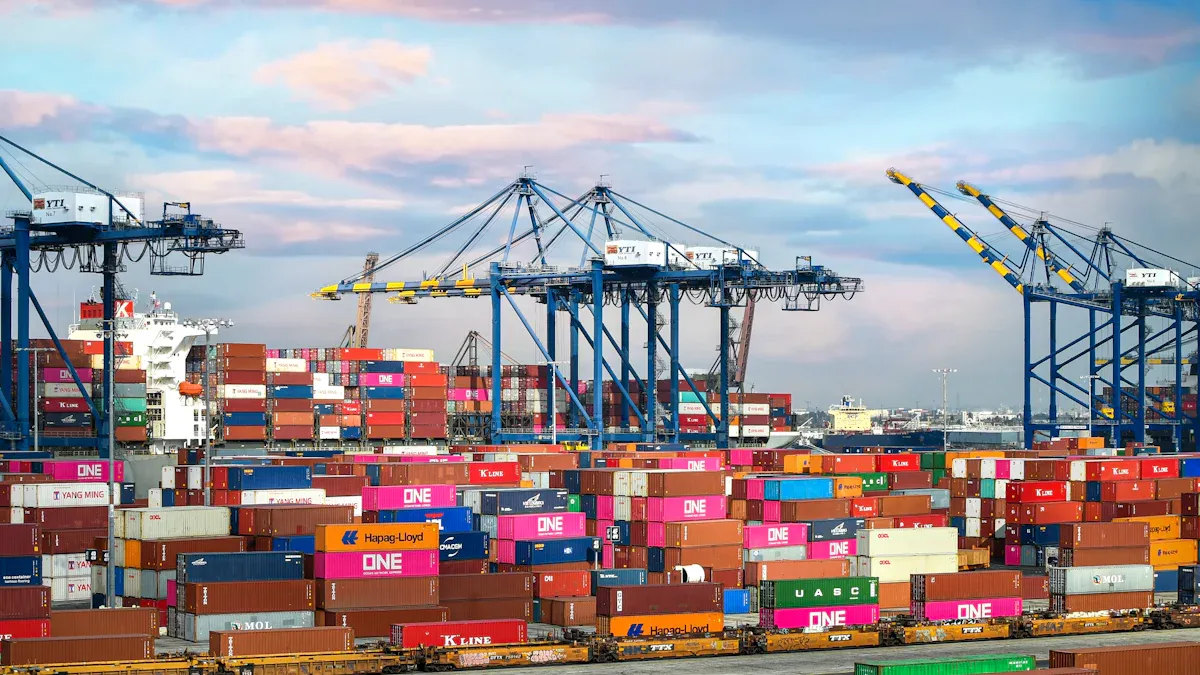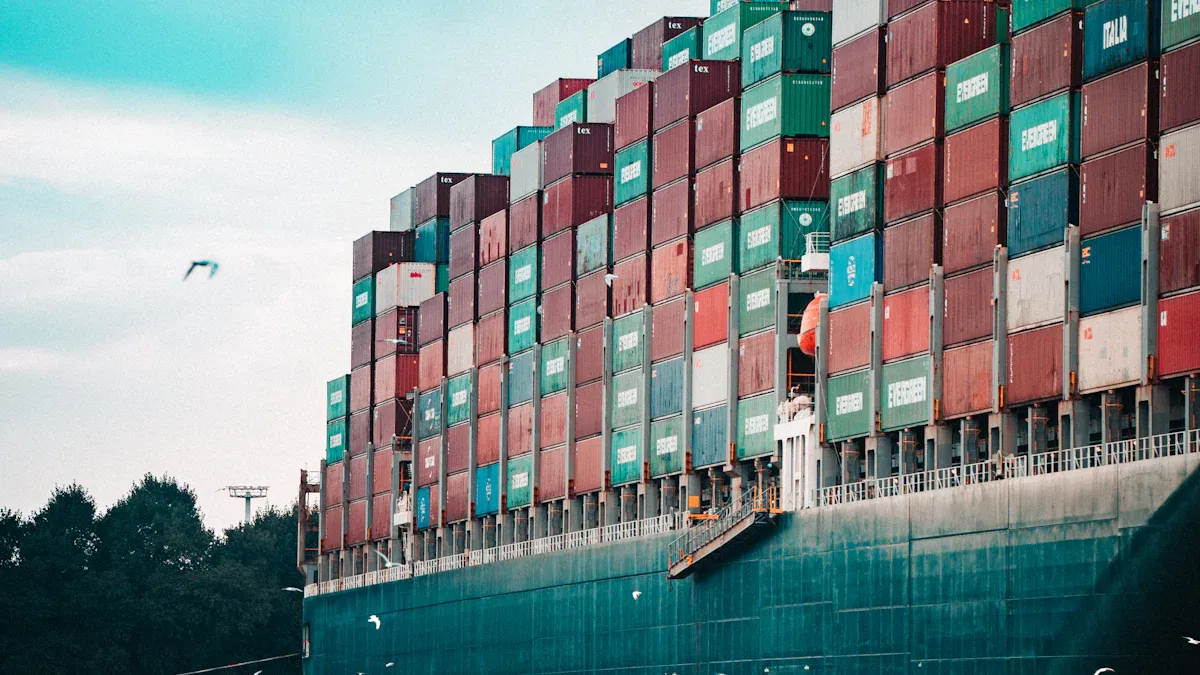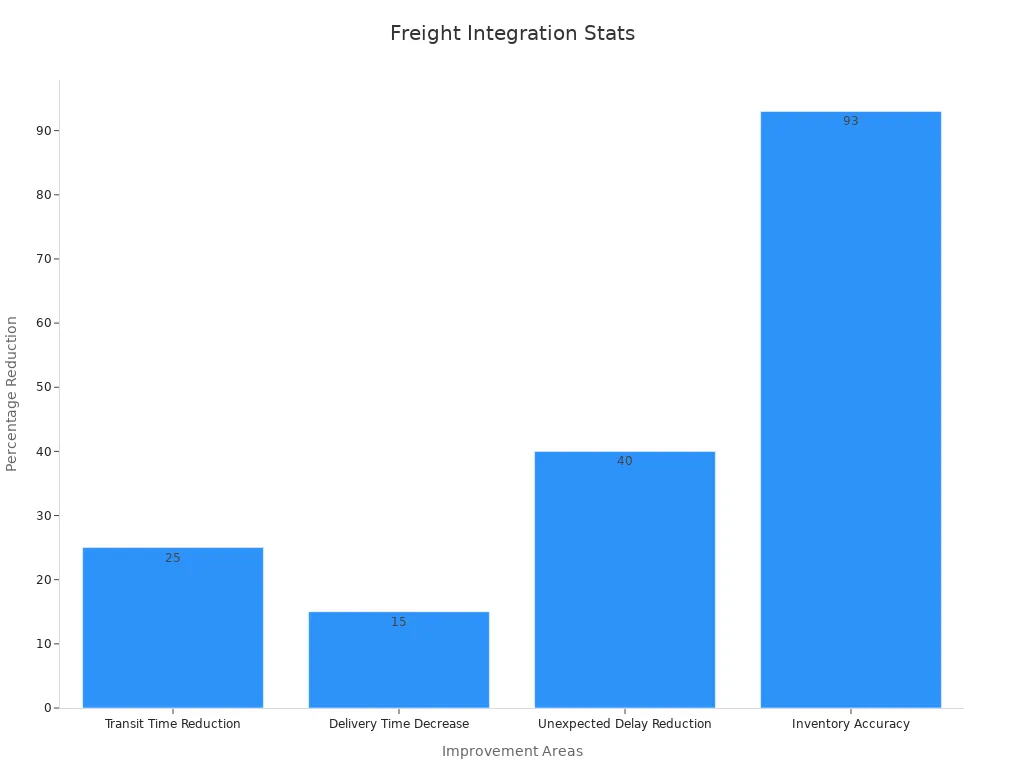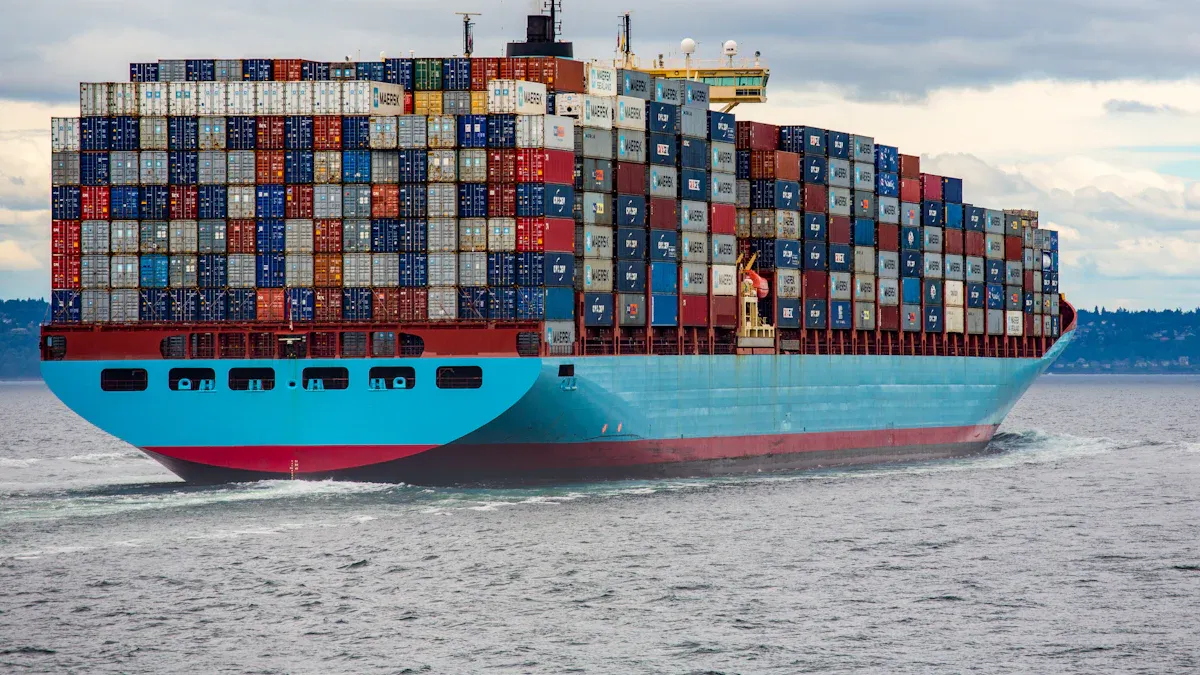How Ocean Freight Logistics Works for Global Trade

Ocean freight logistics helps you move goods across continents. You rely on ocean freight to handle large shipments and keep costs low. Many industries use shipping to reach new markets.
The global ocean freight market is growing fast, fueled by e-commerce and manufacturing in Asia-Pacific.
New technology like AI and automation makes shipping more efficient.
Aspect | Impact on Shipping and Freight |
|---|---|
Higher demand means companies must manage freight carefully and choose the right shipping partners. | |
Rate increases | Shipping costs can rise quickly, so you need to track total freight expenses. |
JUSDA uses smart technology to give you efficient, reliable shipping and warehouse solutions for your freight needs.
Key Takeaways
Ocean freight moves large shipments across continents cost-effectively and supports global trade by connecting markets worldwide.
Technology like AI, automation, and real-time tracking improves shipping efficiency, reduces delays, and lowers costs.
Partnering with experts like JUSDA gives you better control, faster delivery, and smarter logistics through advanced tools and warehouse integration.
Ocean Freight Logistics Overview
What Is Ocean Freight Logistics?
Ocean freight logistics is the process you use to move goods by sea from one country to another. You rely on this system to transport large volumes of products across long distances. Ocean freight logistics covers everything from booking space on a cargo ship to tracking your shipment and managing customs paperwork.
You often choose ocean freight because it is cost-effective for heavy or bulky goods. Ships can carry thousands of containers at once, making ocean transportation the backbone of global shipping. For example, a typical cargo vessel can hold about 18,000 containers per trip. This high capacity helps you move goods at a lower cost compared to air freight. Ocean freight also has a smaller carbon footprint, which supports your sustainability goals.
Here is a quick look at the scale of ocean freight logistics today:
Metric | Value/Statistic |
|---|---|
Global container fleet capacity | |
Fleet growth rate (2024) | 10% increase |
Expected fleet growth (2025) | 7% increase |
Average cargo vessel capacity | ~18,000 containers per ship |
Idle fleet percentage (end 2024) | Less than 1% (all-time low) |
Year-on-year import growth rates | Oceania: 9%, Latin America: 8%, Europe: 6% |
Port congestion impact | 8-10% capacity absorbed by Cape of Good Hope route |
Regulatory impact | ETS emissions surrender increased to 70% from Jan 2025 |
You see that ocean freight logistics supports the movement of goods on a massive scale. This system keeps global supply chains running smoothly.
Role in Global Trade
You depend on ocean freight logistics to connect markets and support international trade. Most of the world’s goods travel by sea. This includes electronics, cars, food, and raw materials. Ocean freight makes it possible for you to buy and sell products worldwide.
Efficient terminal operations help you move cargo quickly. For example, the Port of Los Angeles set a record by handling over 34,000 TEUs in one month. This shows how modern ports can process huge amounts of freight in a short time. When ports use advanced equipment and smart planning, you benefit from faster shipping and lower costs.
Sea-rail intermodal systems also help you move goods from ports to inland destinations. These systems speed up cargo flow and reduce costs. When ports improve storage and handling, you get more reliable sea freight logistics. This efficiency helps you avoid delays and keeps your supply chain strong.
You also see that ocean freight logistics faces challenges like port congestion and rising freight rates. Technology helps solve these problems. Automated cranes, GPS tracking, and better communication tools make shipping more reliable. These advances help you manage risks and keep your freight moving, even when global events cause disruptions.
Tip: Choose ports and partners that invest in technology and efficient operations. This can help you avoid delays and reduce shipping costs.
JUSDA’s Freight Logistics Solutions
You want a logistics partner who understands the complexity of ocean freight. JUSDA stands out as a global supply chain provider with advanced solutions for your shipping needs. JUSDA operates over 155 service points worldwide and manages more than 2.5 million square meters of warehouse space. This network gives you access to reliable sea freight logistics and smooth connections between ocean and land transportation.
JUSDA uses technology to give you real-time tracking and inventory control. With platforms like JusLink, you can see your shipments at every stage. JUSDA’s warehouses use smart systems to manage your goods, from arrival at the port to final delivery. You benefit from value-added services such as picking, packing, and labeling, which help you streamline your supply chain.
Here are some ways technology improves ocean freight logistics for you:
Containerization speeds up loading and unloading, reducing cargo damage.
Automated cranes and stackers lower labor costs and shorten turnaround times.
GPS tracking lets you monitor vessels in real time, improving delivery accuracy.
Advanced vessel designs save fuel and cut emissions, supporting sustainability.
Communication tools give you live updates on weather, vessel location, and cargo status.
Blockchain technology increases transparency and reduces fraud in shipping.
JUSDA’s solutions help you overcome common challenges in ocean freight. You get better visibility, faster response times, and lower costs. When you choose JUSDA, you gain a partner who supports your business growth and helps you succeed in international trade.
Ocean Freight Shipping Process

Step-by-Step Process
You start the ocean freight shipping process by planning your shipment. You decide what goods you need to move and when they must arrive. You then book space on a vessel. This step is called booking. You work with a freight forwarder or a logistics provider to secure your spot on a ship.
The process has three main stages:
Pre-Carriage: You move your goods from your warehouse to the port. You prepare all the documents needed for export. This step includes packing, labeling, and customs paperwork.
Main Carriage: Your goods travel across the ocean. The container stays on the ship until it reaches the destination port. During this stage, you can track your shipment using digital tools. Real-time tracking and automated notifications help you see where your cargo is at any time.
On-Carriage: After the ship arrives, you move your goods from the port to the final delivery point. This step includes customs clearance and inland transportation.
Tip: Plan your shipments early. This helps you avoid extra charges and makes sure you get space on the ship.
You can use freight management software to compare rates, track your shipment, and find the best route. These tools help you save money and time. When you consolidate shipments using Less Than Container Load (LCL), you can reduce costs by sharing space with other shippers.
Here is a table that shows how you can measure each stage of the process:
Process Stage / Aspect | Key Performance Indicators (KPIs) and Analytics Examples |
|---|---|
Booking Efficiency | Time to book cargo, success rate of bookings, average booking time |
Shipment Visibility | Tracking cargo location, expected arrival time, delay notifications |
Carrier Performance | Cargo handling effectiveness, vessel schedule adherence, on-time performance |
Rate Management | Rate competitiveness, rate volatility, cost-effectiveness of routes |
Capacity Utilization | Cargo distribution, space allocation, container fill rate |
Cargo Turnaround Time | Loading and unloading duration, port transfer times |
Inventory Management | Storage costs, demand forecasting accuracy, inventory levels |
Environmental Sustainability | Emissions data, fuel consumption, carbon footprint |
Customer Satisfaction | Customer feedback, response times, problem resolution rates |
Risk Assessment and Mitigation | Weather forecasts, geopolitical risks, economic trends |
Financial Metrics | Sales, profit margins, operational expenses |
Compliance and Regulatory | Adherence to shipping laws and industry standards |
Predictive Analytics | Demand forecasting based on market trends and historical data |
Route Optimization | Travel time reduction, cost savings, traffic and weather considerations |
Port Performance | Vessel turnaround time, container handling efficiency, port traffic density |
Supplier and Vendor Metrics | Lead times, product quality, supplier performance |
Quality of Service | Cargo condition at delivery, delivery accuracy, customer feedback |
You can use these KPIs to check how well your ocean freight shipping process works. Tracking these numbers helps you find problems and improve your shipping operations.
Freight Forwarders and JUSDA’s Role
Freight forwarders help you manage the details of ocean freight shipping. They act as your partner, handling paperwork, booking, and coordination with carriers. You rely on them to make sure your goods move smoothly from start to finish.
JUSDA takes this role further by using advanced technology and a global network. You get real-time tracking, predictive analytics, and automated updates. These tools help you see your shipment’s status and plan for any changes. JUSDA’s JusLink platform lets you monitor your freight at every step. You can spot delays early and adjust your plans.
When you work with JUSDA, you benefit from:
A 25% reduction in transit times. Machine learning helps choose the best routes and avoid delays.
A 15% decrease in delivery times. Predictive analytics improve scheduling and resource use.
A 40% drop in unexpected delays. Real-time GPS and RFID tracking let you reroute shipments quickly.
A 93% improvement in inventory accuracy. RFID tags give you precise, real-time data on your cargo.

JUSDA’s freight logistics solutions help you avoid common problems in ocean freight. You get better visibility, faster response times, and more control over your shipments. This support helps you keep your supply chain strong and your customers happy.
Shipping via Ocean Freight: Key Stages
You can break down shipping via ocean freight into several key stages. Each stage has its own benchmarks and performance measures. By tracking these, you can improve your freight logistics and avoid costly mistakes.
Vessel Schedule Reliability: You measure how often ships arrive on time. This helps you manage time-sensitive shipments.
Vessel Discharge to Final Delivery Cycle Time: You track how long it takes to move goods from the port to the final delivery point. This shows you where delays happen.
Demurrage & Per Diem Costs: You watch for extra charges when containers stay too long at the port. High costs mean you need to speed up your pickup and delivery.
Average Inland Transit Times: You check how fast your goods move from the port to your warehouse. Shorter times mean better efficiency.
Container Turnaround Time: You see how long containers stay at your warehouse. Faster turnaround lowers your costs.
You also use other benchmarks:
On-Time Pickup Percentage: You track how often pickups happen as planned.
Perfect Order Measurement: You check how many orders arrive without errors.
Adherence to On-Time Deliveries: You make sure deliveries meet customer deadlines.
Accurate Freight Bills: You review billing accuracy to avoid payment issues.
Note: Tracking these benchmarks helps you spot problems early. You can fix issues before they affect your customers.
By using these measures, you make your ocean freight shipping process more reliable. You save money, reduce risks, and keep your customers satisfied. JUSDA’s technology and expertise help you reach these goals, making your freight logistics smarter and more efficient.
Types and Benefits of Ocean Freight

Types of Ocean Freight
You have several options when choosing ocean freight for your shipping needs. Each type fits different cargo and business goals.
Full Container Load (FCL): You use the entire container for your goods. This method works best for large shipments or high-value items. FCL offers faster shipping and less risk of damage because only your freight is inside the container.
Less-Than-Container Load (LCL): You share the container with other shippers. LCL is cost-effective for smaller shipments. You pay only for the space you use, but your freight may take longer to arrive due to extra handling.
Bulk Shipping: You move unpackaged goods like grains, coal, or minerals. Bulk shipping uses special vessels, not containers. This method suits large volumes of loose cargo.
Roll-on/Roll-off (RORO): You ship vehicles or machinery that can roll on and off the vessel. RORO shipping is fast and safe for cars, trucks, and heavy equipment.
Type | Best For | Speed | Cost Structure | Handling Risk |
|---|---|---|---|---|
FCL | Large, single shipments | Fast | Fixed per container | Low |
LCL | Small, mixed shipments | Moderate | Pay by volume/weight | Higher |
Bulk | Loose, high-volume | Variable | By tonnage | Moderate |
RORO | Vehicles, machinery | Fast | By unit | Low |
JUSDA Warehouse Integration
You gain more control over your ocean freight shipments with JUSDA’s warehouse solutions. JUSDA uses AI and cloud platforms to track your container and freight in real time. You see your shipping status and charges before your container arrives. Automation helps you handle documents, payments, and billing faster. JUSDA’s BI dashboards give you instant access to key shipping data. This integration reduces delays and keeps your supply chain moving. You can focus on growing your business while JUSDA manages your freight and warehouse needs.
Tip: Use JUSDA’s automated tools to improve your shipping accuracy and reduce manual work.
Pros and Cons of Ocean Freight
Ocean freight gives you many benefits. You can move large volumes at a lower cost than air shipping. You get flexible options with FCL, LCL, bulk, and RORO. You also lower your carbon footprint by choosing ocean shipping. However, you must plan for longer transit times and possible delays at ports. You need to track your container and manage paperwork. JUSDA helps you overcome these challenges with smart technology and strong warehouse support. You get reliable shipping, better visibility, and improved efficiency. The benefits of ocean freight make it a smart choice for many businesses.

JUSDA Solutions
To provide you with professional solutions and quotations.
You drive business growth when you choose advanced ocean freight logistics and strong warehouse integration. JUSDA helps you optimize every step. Studies show that working with expert logistics partners improves efficiency, cost control, and supply chain performance.
Smart logistics decisions help you meet deadlines, reduce costs, and keep your customers happy.
